Home > Textbooks > Basic Electronics > Rectifiers > Smoothing Filters >
Rectifiers
Smoothing Filters
While the output of a rectifier is a pulsating DC, most electronic circuits require a substantially pure DC for proper operation. This type of output is provided by single or multisection filter circuits placed between the output of the rectifier and the load.
There are four basic types of filter circuits:
- Simple capacitor filter
- LC choke-input filter
- LC capacitor-input filter (pi-type)
- RC capacitor-input filter (pi-type)
The function of each of these filters will be covered in detail in this section.
Filtering is accomplished by the use of capacitors, inductors, and/or resistors in various combinations. Inductors are used as series impedances to oppose the flow of alternating (pulsating DC) current. Capacitors are used as shunt elements to bypass the alternating components of the signal around the load (to ground). Resistors are used in place of inductors in low current applications.
Let's briefly review the properties of a capacitor. First, a capacitor opposes any change in voltage. The opposition to a change in voltage is called capacitive reactance (XC) and is measured in ohms. The capacitive reactance is determined by the frequency (f) of the applied voltage and the capacitance (C) of the capacitor:

From the formula, you can see that if frequency or capacitance is increased, the XC decreases. Filter capacitors are placed in parallel with the load. The capacitor acts as a short circuit for the AC component (ripple) of the voltage. A low XC will provide a smaller opposition to the AC component and thus better filtering than a high XC. Therefore, to obtain the best possible filtering, you want the capacitor to be as large as possible.
Another consideration in filter circuits are the charging and discharging times of the capacitor circuits. In filter circuits the capacitor is the common element to both the charge and the discharge paths (see the figure below). The other element of the charge path (solid line in the figure) is the internal resistance of the power supply, while the other element of the discharge path (dashed line in the figure) is the resistance of the load. So the charge and the discharge paths contains a resistance-capacitance circuit.

The time constant of the resistance-capacitance circuit is defined as the time it takes a capacitor to charge to 63.2 percent of the applied voltage or to discharge to 36.8 percent of its total voltage. The time constant τ (RC time constant) can be expressed by the following equation:
![]()
where R represents the resistance of the charge or discharge path and C represents the capacitance of the capacitor. It should be noted that a capacitor is considered fully charged after five RC time constants.
To obtain a steady DC output, the capacitor must charge almost instantaneously to the value of applied voltage. The capacitor filter must have a short charge time constant. This can be accomplished by keeping the internal resistance of the power supply as small as possible. Once charged, the capacitor must retain the charge as long as possible. This can be accomplished by keeping the resistance of the load as large as possible (for a slow discharge time).
Now let's look at inductors and their application in filter circuits. Remember, an inductor opposes any change in current. A change in current through an inductor produces a changing electromagnetic field. The changing field, in turn, cuts the windings of the wire in the inductor and thereby produces a back electromotive force (BEMF). It is the BEMF that opposes the change in circuit current. Opposition to a change in current at a given frequency is called inductive reactance (XL) and is measured in ohms. The inductive reactance (XL) of an inductor is determined by the applied frequency and the inductance of the inductor.
Mathematically,
![]()
If frequency or inductance is increased, the XL increases. Since inductors are placed in series with the load, the larger the XL, the smaller the AC voltage developed across the load.
Now that you have read about the components in filter circuits, the different types of filter circuits will be discussed.
The Capacitor Filter
The simple capacitor filter is the most basic type of power supply filter. The capacitor (C) shown in the figure below is a simple capacitor filter connected across the output of the rectifier in parallel with the load. The value of the capacitor is usually fairly large, thus it presents a relatively low reactance to the pulsating current.

When this filter is used, the charge time of the filter capacitor (C) must be short and the discharge time must be long to eliminate ripple action. In other words, the capacitor must charge up fast, preferably with no discharge at all. Better filtering also results when the input frequency is high; therefore, the full-wave rectifier output is easier to filter than that of the half-wave rectifier because of its higher frequency.
The rate of charge for the capacitor is limited by the resistance of the conducting diode which is relatively low. Therefore, the charge time of the circuit is relatively short. As a result, when the pulsating voltage is first applied to the circuit, the capacitor charges rapidly and almost reaches the peak value of the rectified voltage within the first few cycles. The capacitor attempts to charge to the peak value of the rectified voltage anytime a diode is conducting, and tends to retain its charge when the rectifier output falls to zero. (The capacitor cannot discharge immediately.) The capacitor slowly discharges through the load resistance (RL) during the time the rectifier is nonconducting.
The rate of discharge of the capacitor is determined by the value of capacitance and the value of the load resistance. If the capacitance and load-resistance values are large, the discharge time for the circuit is relatively long.
Now, let's consider a complete cycle of operation using a half-wave rectifier, a capacitive filter (C), and a load resistor (RL). As shown in view A of the figure below, the capacitive filter (C) is assumed to be large enough to ensure a small reactance to the pulsating rectified current. The resistance of RL is assumed to be much greater than the reactance of C at the input frequency. When the circuit is energized, the diode conducts on the positive half cycle and current flows through the circuit, allowing C to charge. C will charge to approximately the peak value of the input voltage. (The charge voltage is less than the peak value because of the voltage drop across the diode D). In view A of the figure, the charging of C is indicated by the heavy solid line on the waveform. After the capacitor has charged to its peak value, it tends to retain its charge when the rectifier output falls to zero. Since the fall of this voltage on the anode is considerably more rapid than the decrease of the capacitor voltage, the cathode quickly become more positive than the anode, and the diode ceases to conduct. The capacitor will start to discharge through the load resistor RL.
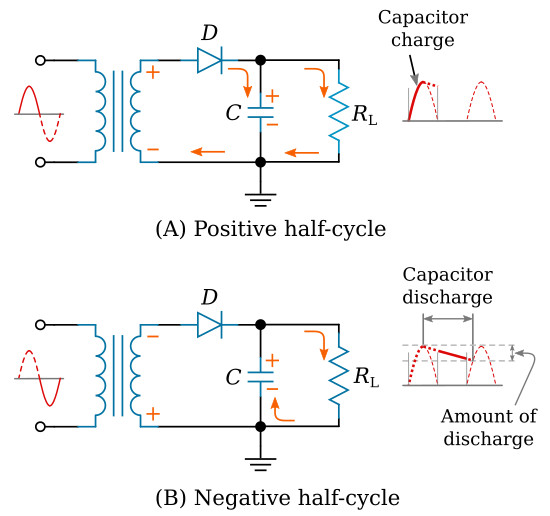
As illustrated in view B, the diode cannot conduct on the negative half cycle because the anode of D is negative with respect to the cathode. During this interval, C discharges through the load resistor (RL). The discharge of C produces the downward slope as indicated by the solid line on the waveform in view B. In contrast to the abrupt fall of the applied AC voltage from peak value to zero, the voltage across C (and thus across RL) during the discharge period gradually decreases until the time of the next half cycle of rectifier operation. Keep in mind that for good filtering, the filter capacitor should charge up as fast as possible and discharge as little as possible.
Since practical values of C and RL ensure a more or less gradual decrease of the discharge voltage, a substantial charge remains on the capacitor at the time of the next half cycle of operation. As a result, no current can flow through the diode until the rising AC input voltage at the anode of the diode exceeds the voltage remaining on C. The voltage on C is the cathode potential of the diode. When the potential on the anode exceeds the potential on the cathode (the voltage on C), the diode again conducts, and C begins to charge to approximately the peak value of the applied voltage.
A comparison of a rectifier circuit with a capacitor and one without a capacitor is illustrated in view B of the figure above. With no capacitor connected across the output of the rectifier circuit, the output waveform (dashed line) has a large pulsating component (ripple) compared with the average or DC component (Vavg = 0.318×Vpeak). When a capacitor is connected across the output, the average value of output voltage (Vavg) is increased and the ripple is decreased due to the filtering action of capacitor C.
Operation of the simple capacitor filter using a full-wave rectifier is basically the same as that discussed for the half-wave rectifier. Referring to the figure below, you should notice that because one of the diodes is always conducting on either alternation, the filter capacitor charges and discharges during each half cycle. (Note that each diode conducts only for that portion of time when the peak secondary voltage is greater than the voltage across the capacitor.)
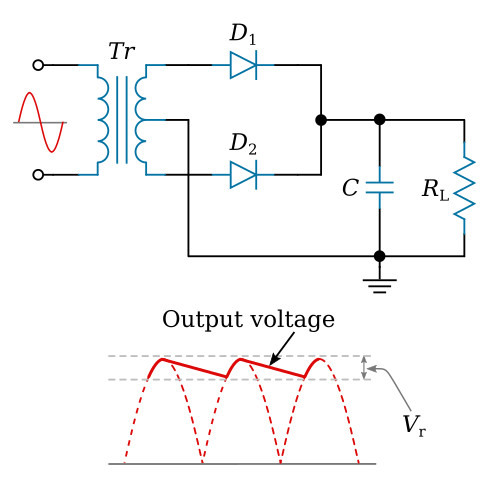
Another thing to keep in mind is that the ripple component (Vr) of the output voltage is an AC voltage and the average output voltage (Vavg) is the DC component of the output. Since the filter capacitor offers a relatively low impedance to AC, the majority of the AC component flows through the filter capacitor. The AC component is therefore bypassed (shunted) around the load resistance, and the entire DC component (or Vavg) flows through the load resistance. This statement can be clarified by using the formula for XC in a half-wave and full-wave rectifier. First, you must establish some values for the circuit.
Half-wave rectifier:
Frequency at rectifier output: 60 Hz
Capacitance of filter capacitor: 30 µF
Load resistance: 10 kΩ
The capacitive reactance

Full-wave rectifier:
Frequency at rectifier output: 120 Hz
Capacitance of filter capacitor: 30 µF
Load resistance: 10 kΩ
The capacitive reactance

As you can see from the calculations, by doubling the frequency of the rectifier, you reduce the impedance of the capacitor by one-half. This allows the AC component to pass through the capacitor more easily. As a result, a full-wave rectifier output is much easier to filter than that of a half-wave rectifier. Remember, the smaller the XC of the filter capacitor with respect to the load resistance, the better the filtering action. Since

the largest possible capacitor will provide the best filtering. Remember, also, that the load resistance is an important consideration. If load resistance is made small, the load current increases, and the average value of output voltage (Vavg) decreases. The discharge time constant is a direct function of the value of the load resistance; therefore, the rate of capacitor voltage discharge is a direct function of the current through the load. The greater the load current, the more rapid the discharge of the capacitor, and the lower the average value of output voltage. For this reason, the simple capacitive filter is seldom used with rectifier circuits that must supply a relatively large load current. Using the simple capacitive filter in conjunction with a full-wave (bridge) rectifier provides improved filtering because the increased ripple frequency decreases the capacitive reactance of the filter capacitor.
LC Choke-Input Filter
The LC choke-input filter is used primarily in power supplies where voltage regulation is important and where the output current is relatively high and subject to varying load conditions. This filter is used in high power applications such as those found in radars and communication transmitters.
Notice in the figure below that this filter consists of an input inductor (L), or filter choke, and an output filter capacitor (C). Inductor is placed at the input to the filter and is in series with the output of the rectifier circuit. Since the action of an inductor is to oppose any change in current flow, the inductor tends to keep a constant current flowing to the load throughout the complete cycle of the applied voltage. The reactance of the inductor (XL) reduces the amplitude of ripple voltage without reducing the DC output voltage by an appreciable amount. (The DC resistance of the inductor is usually just a few ohms.) The larger the value of the filter inductor, the better the filtering action.
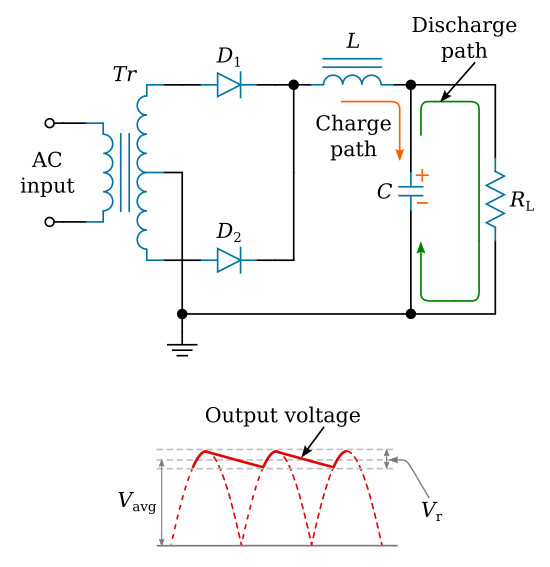
The shunt capacitor (C) charges and discharges at the ripple frequency rate. The reactance of the shunt capacitor (XC) presents a low impedance to the ripple component existing at the output of the filter, and thus shunts the ripple component around the load. The capacitor attempts to hold the output voltage relatively constant.
The value of the filter capacitor (C) must be relatively large to present a low opposition (XC) to the pulsating current and to store a substantial charge. The larger the value of the filter capacitor, the better the filtering action. However, because of physical size, there is a practical limitation to the maximum value of the capacitor.
Now look at the figure above which illustrates a complete cycle of operation for a full-wave rectifier circuit used to supply the input voltage to the filter. The rectifier voltage is developed across the capacitor (C). The ripple voltage at the output of the filter is the alternating component of the input voltage reduced in amplitude by the filter section. Each time the anode of a diode goes positive with respect to the cathode, the diode conducts and C charges. Conduction occurs twice during each cycle for a full-wave rectifier. For a 60-hertz supply, this produces a 120-hertz ripple voltage. Although the diodes alternate (one conducts while the other is nonconducting), the filter input voltage is not steady. As the anode voltage of the conducting diode increases (on the positive half of the cycle), capacitor C charges - the charge being limited by the impedance of the secondary transformer winding, the diode's forward (anode-to-cathode) resistance, and the back electromotive force developed by the choke. During the nonconducting interval (when the anode voltage drops below the capacitor charge voltage), C discharges through the load resistor (RL). C will only partially discharge, as the components in the discharge path have a long time constant τ (discharge time constant). As the charge time constant is normally short compared to the discharge time constant, the capacitor C discharges more slowly than it charges.
The filtering action is also illustrated in the figure below. The inductor (L) and the capacitor (C) form a voltage divider for the AC component (ripple) of the applied input voltage. This is shown in view A of the figure below. As far as the ripple component is concerned, the inductor offers a high impedance (Z) and the capacitor offers a low impedance (view B). As a result, the ripple component (Vr) appearing across the load resistance is greatly attenuated (reduced).

Now that you have read how the LC choke-input filter functions, it will be discussed with actual component values applied. For simplicity, the input voltage at the primary of the transformer will be 117 volts 60 hertz. Both half-wave and full-wave rectifier circuits will be used to provide the input to the filter.
Starting with the half-wave configuration shown in the figure below, the basic
parameters are:
With 117 volts AC (RMS value) applied to the Tr primary,
165 volts AC peak is available at the secondary (117 × 1.414 = 165 V).
You should recall that the ripple frequency of this half-wave rectifier is
60 hertz. Therefore, the capacitive reactance of C is:

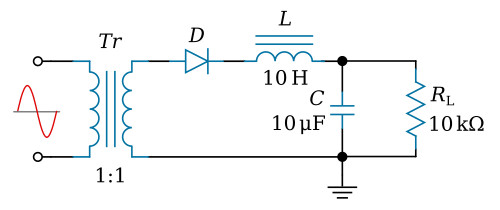
This means that the capacitor offers 265 ohms of opposition to the ripple current. Note, however, that the capacitor offers an infinite impedance to direct current. The inductive reactance of L is:

The above calculation shows that L offers a relatively high opposition (3.8 kilohms) to the ripple in comparison to the opposition offered by C (265 ohms). Thus, more ripple voltage will be dropped across L than across C. In other words, the ripple voltage appearing across the load resistance is attenuated. In addition, the impedance of C (265 ohms) is relatively low with respect to the resistance of the load (10 kilohms). Therefore, more ripple current flows through C than the load. In other words, C shunts most of the AC component around the load. You can further increase the ripple voltage across L by increasing the inductance.
Now let's discuss the DC component of the applied voltage. Remember, a capacitor offers an infinite (∞) impedance to the flow of direct current. The DC component, therefore, must flow through RL and L. As far as the DC is concerned, the capacitor does not exist. The choke and the load are therefore in series with each other. The DC resistance of a filter choke is very low (can be about 50 ohms). Consequently, most of the DC component is developed across the load and a very small amount of the DC voltage is dropped across the choke, as shown in the figure below.

As you may have noticed, both the AC and the DC components flow through L. Because it is frequency sensitive, the choke provides a large resistance to AC and a small resistance to DC. In other words, the choke opposes any change in current. This property makes the choke a highly desirable filter component.
Note that the filtering action of the LC choke-input filter is improved when the filter is used in conjunction with a full-wave rectifier, as shown in the figure below. This is due to the decrease in the XC of the filter capacitor and the increase in the XL of the choke. Remember, ripple frequency of a full-wave rectifier is twice that of a half-wave rectifier. For 60-hertz input, the ripple will be 120 hertz. The XC of C and the XL of L are calculated as follows:

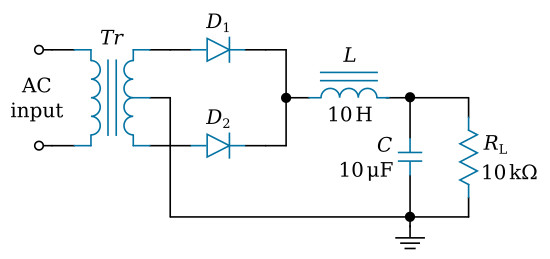
When the XC of a filter capacitor is decreased, it provides less opposition to the flow of AC. The greater the AC flow through the capacitor, the lower the flow through the load. Conversely, the larger the XL of the choke, the greater the amount of AC ripple developed across the choke; consequently, less ripple is developed across the load and better filtering is obtained.
Resistor-Capacitor (RC) Filters
The single capacitor filter is suitable for many noncritical, low-current applications. However, when the load resistance is very low or when the percent of ripple must be held to an absolute minimum, the capacitor value required must be extremely large. While electrolytic capacitors are available in sizes up to 10 mF or greater, the large sizes are quite expensive. A more practical approach is to use a more sophisticated filter that can do the same job but that has lower capacitor values, such as the RC filter. The RC capacitor-input filter is limited to applications in which the load current is small. This type of filter is used in power supplies where the load current is constant and voltage regulation is not necessary.
The figure below shows an RC capacitor-input filter and associated waveforms. Both half-wave and full-wave rectifiers are used to provide the inputs. The waveforms shown in view A of the figure represent the unfiltered output from typical rectifier circuits. The average value of output voltage Vavg for the half-wave rectifier is less than half (approximately 0.318) the amplitude of the voltage peaks. The average value of output voltage for the full-wave rectifier is greater than half (approximately 0.637), but is still much less than, the peak amplitude of the rectifier-output waveform. With no filter circuit connected across the output of the rectifier circuit (unfiltered), the waveform has a large value of pulsating component (ripple) as compared to the average (or DC) component.
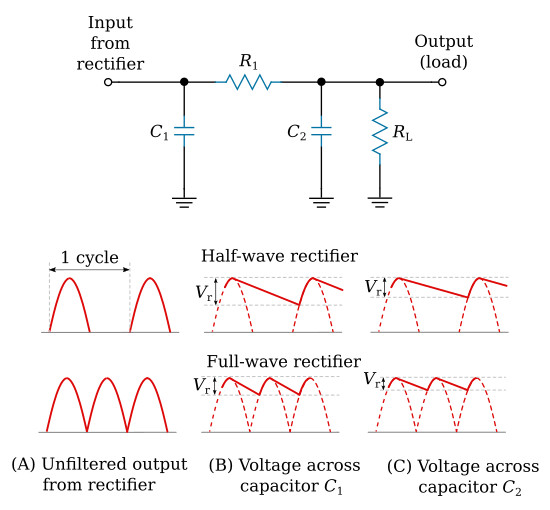
The RC filter in the figure above consists of an input filter capacitor (C1), a series resistor (R1), and an output filter capacitor (C2). (This filter is sometimes referred to as an RC pi-section filter because its schematic symbol resembles the Greek letter π).
C1 performs exactly the same function as it did in the single capacitor filter. It is used to reduce the percentage of ripple to a relatively low value (view B). This voltage is passed on to the R1-C2 network, which reduces the ripple even further.
C2 offers an infinite impedance to the DC component of the output voltage. Thus, the DC voltage is passed to the load, but reduced in value by the amount of the voltage drop across R1. However, R1 is generally small compared to the load resistance. Therefore, the drop in the DC voltage by R1 is not a drawback.
Component values are designed so that the resistance of R1 is much greater than the reactance (XC) of C2 at the ripple frequency. Therefore, most of the ripple voltage is dropped across R1. Only a trace of the ripple voltage can be seen across C2 and the load (view C). In extreme cases where the ripple must be held to an absolute minimum, a second stage of RC filtering can be added. In practice, the second stage is rarely required. The RC filter is extremely popular because smaller capacitors can be used with good results.
The RC filter has some disadvantages. First, the voltage drop across R1 takes voltage away from the load. Second, power is wasted in R1 and is dissipated in the form of unwanted heat. Finally, if the load resistance changes, the voltage across the load will change. Even so, the advantages of the RC filter overshadow these disadvantages in many cases.
LC Capacitor-Input Filter
The LC capacitor-input filter is one of the most commonly used filters. This type of filter is used in any type of power supply where the output current is low and the load current is relatively constant.
The figure below shows an LC capacitor-input filter and associated waveforms, which are similar to the case of RC filter shown above. Both half-wave and full-wave rectifier circuits are used to provide the input. The waveforms shown in view A of the figure represent the unfiltered output from a typical rectifier circuit. Note that the average value of output voltage (Vavg) for the half-wave rectifier is less than half the amplitude of the voltage peaks. The average value of output voltage for the full-wave rectifier is greater than half, but is still much less than the peak amplitude of the rectifier-output waveform. With no filter connected across the output of the rectifier circuit (which results in unfiltered output voltage), the waveform has a large value of pulsating component (ripple) as compared to the average (or DC) component.
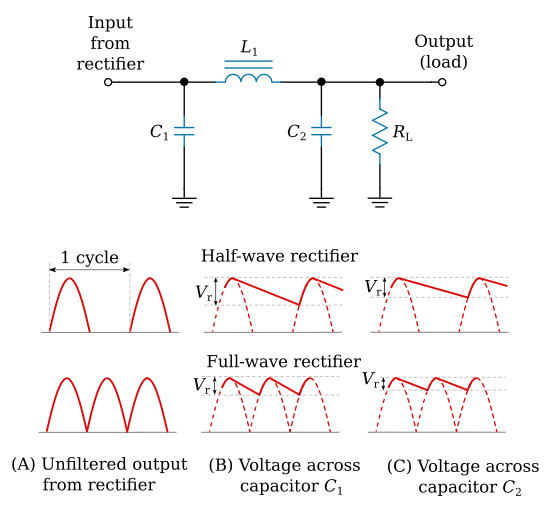
C1 reduces the ripple to a relatively low level (view B). L1 and C2 form the LC filter, which reduces the ripple even further. L1 is a large value iron-core inductor (choke). L1 has a high value of inductance an therefore, a high value of XL which offers a high reactance to the ripple frequency. At the same time, C2 offers a very low reactance to AC ripple. L1 and C2 form an AC voltage divider and, because the reactance of L1 is much higher than that of C2, most of the ripple voltage is dropped across C1. Only a slight trace of ripple appears across C2 and the load (view C).
While the L1-C2 network greatly reduces AC ripple it has little effect on DC. You should recall that an inductor offers no reactance to DC. The only opposition to current flow is the resistance of the wire in the choke. Generally, this resistance is very low and the DC voltage drop across the inductor is minimal. Thus, the LC filter overcomes the disadvantages of the RC filter.
The LC filter provides good filtering action over a wide range of currents. The capacitor filters are best when the load is drawing little current. Thus, the capacitor discharges very slowly and the output voltage remains almost constant. On the other hand, the inductor filters are best when the current is highest. The complementary nature of these two components ensures that good filtering will occur over a wide range of currents.
The LC filter has two disadvantages. First, it is more expensive than the RC filter because an iron-core choke costs more than a resistor. The second disadvantage is size. The iron-core choke is bulky and heavy, a fact which may render the LC filter unsuitable for many applications.






